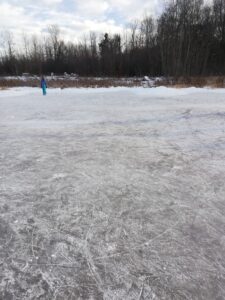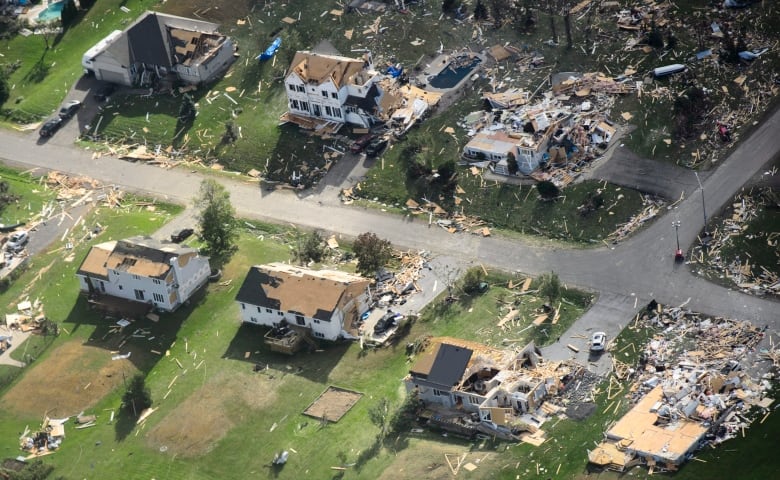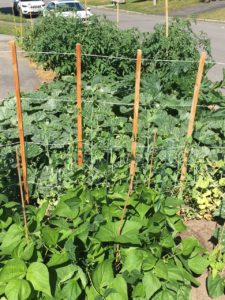Garden Envy
For many years, my neighbour, Jim, and I had lamented the state of our yards. Slowly, dead patches were replaced by flowers, fallen trees by rock gardens, and decks appeared. However, the bane of our existence continued to be our boulevards. No amount of seeds or sod could stop the plethora of weeds from taking root and providing an unsightly mess each summer. Without lawn mowers, we had to rely on the kindness of neighbours or more primitive measures.
During those years, we had also talked about a garden. I have many fond memories of gardening as a child and worked on sustainable development and food security issues with the UN. Jim had a keen interest in trying his hand at urban agriculture. Despite our interest in food production, we simply didn’t have enough room or sunlight in our backyards to sustain it. Raised gardens were a possibility, but where would we put them? How would I care for them never being home? Jim became occupied with building a greenhouse (by hand!), and I concentrated on my flower garden. The universe, however, had different ideas.
Covid 19 Opportunities
2020 has been an interesting year to say the least. While it has had its share of negatives, it has also provided many opportunities to take stock of how we spend our time, and to make time for those activities many of us have been putting on the back burner. In a little corner of our community – Pigeon Terrace – one of those opportunities was the time to grow a wonderful garden. What became known as the Pigeon Patch not only provided a wonderful source of food and activity, but a means to meet neighbours, share stories, educate children, and provide respite in the face of a global pandemic. This is our story.
Enter COVID-19. In the space of a few weeks, many of us were working from home. Gyms, rinks and stores were closed. Limits were placed on social gatherings. In a stroke of luck, however, it was March. Spring was just around the corner and, with spring, gardens. We agreed that if there was ever to be a year to plant a vegetable garden, this would be it, and what better place for a garden than the sunny, weed-filled boulevard.
Making it Happen
The first step was to reach out to the city to ensure the garden would be allowed. After all, who wants to go through all of that work only to have it removed?! Despite many conversations, the guidance was ambiguous. In the end, we were told that as long as nothing permanent was installed on the boulevard, and the vegetation did not impede road safety, it would be allowable.
The next step: come up with a plan. I drew up a visual of my garden and began to source seeds and material (including Get Growing Hunt Club!). Jim started to turn up the soil, and had additional soil delivered. I added peat and manure to improve the condition of the soil. Jim had a soaker hose, which he was willing to install the length of our garden. We researched how to grow items that we had never attempted before. Fortunately, Ottawa has a great climate for growing vegetables (Zone 5a), and amazing resources for gardeners, new and old (refer to the end of this article for a list of some of our favourites). By the end of May, beds were prepared, and seeds and plants were planted.
. 

The Waiting Game
Have I mentioned, however, that patience is the enemy of a gardener? That first month can be frustrating, with hours spent weeding and foiling the attempts of squirrels to dig up seedlings, while seeds take their sweet time to appear. Even a good gardening playlist can find it tough to pick you up. This is a great time to remind yourself of the benefits of what you are doing. As they say, mindset is everything!
Over the months, the days got warmer, and plants appeared: radishes, beans, zucchini, cucumbers, tomatoes, squash, potatoes, peppers, and eggplants. Seedlings were booby-trapped with wooden skewers and plastic forks. Supports were added to keep plants off the ground and help them grow. Once plants were well-established, bales of straw were placed on the garden beds to help with weed control and water retention, and the time to weed went from hours to minutes. Jim made sure to water the bed deeply every morning, and I tried to get a handle on the powdery mildew that appeared. We enjoyed our first harvest the second week of July and, despite a bit of frost and snow, removed the last of the vegetables in early November! The amount of food surprised even us, and the food in my freezer will easily get me through any lockdown!




Benefits of Gardening
The benefits of gardening are well-documented but have faded into the background as societies become more urban and less connected to their food sources. Gardening is a source of wellness, learning, and sustainability. It is also a source of community and cohesiveness. Can’t make it to the gym? Gardening is a source of low-impact exercise that allows you to enjoy being out in the sun and fresh air. Kids are bored of online learning. Watch them light up as they start to recognize that little sprout is something they can eat. Struggling to make ends meet? Growing your own food helps stretch your dollar and provides food security for many. Feeling isolated? Tending to your garden allows you to meet your neighbours and share experiences that you may not otherwise have had.
We hope that our experience will inspire you to try your hand at gardening. If you are interested in growing your own garden, here are some simple rules to follow: 1) Start small: you want your garden to be enjoyable, and not a source of frustration; 2) Have a plan: taking the time to prepare your garden and grow the right things in the right place will set you up for success; 3) Grow what you eat: remember that little zucchini plant will be prolific come July; 4) Water. Weed. Check for pests. Rinse. Repeat; 5) Share your bounty, and enjoy the experience: your body, friends, and neighbours will thank you for it!
Looking to the Future
What is next for us? We’re expanding. The garden will be back next year, with modifications to what we grow (those mung beans took up a lot of space, and 400 tomatoes might be a bit much) and staggered planting. Jim’s greenhouse will be operational next season. We’ve also been asked to help and share our plans with neighbours who installed, or plan to install, their own gardens. Perhaps there will even be time to work with the city and others to review the bylaw and encourage this type of land use. With growing interest in health and wellbeing, the environment, and food security, this would be a wonderful opportunity for the City of Ottawa to expand its green initiatives and actively promote urban gardening!
While the garden has been put to rest for the season, we’re already thinking about next year. Feel free to stop by the Pigeon Parch and say hello.
Resources
Some of our favourite resources:
- Get Growing Hunt Club: hunt-club.ca/getgrowing
- Master Gardeners of Ottawa-Carleton: mgottawa.ca
- Soil: Greely Sand and Gravel; Maurice Yelle
- Plants: Greta’s Organic Gardens; Peter Knippel
- Straw (and plants): Ritchie’s Feed and Seed
- Mulch: Landscape Depot
- Tools: Lee Valley Tools


 To the west, Quinterra and Hunt Club Woods are serviced by the commercial area on Riverside from Uplands to Rivergate Way. It has restaurants and greenspace but lacks food shops, schools, and is divided by the Riverside commuter route.
To the west, Quinterra and Hunt Club Woods are serviced by the commercial area on Riverside from Uplands to Rivergate Way. It has restaurants and greenspace but lacks food shops, schools, and is divided by the Riverside commuter route.




























